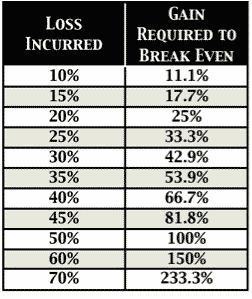Day Trading Rules And Risk Management
 May 21, 2013 at 4:22 PM
May 21, 2013 at 4:22 PM (QQQ)(DIA)(SPY)(GLD)(AAPL)
Risk Management Rules For Day Trading
Our series on Day Trading Rules will end with this final installment on Risk Management. Let us first turn to Webster for a clear textbook definition. I knew risk management was a serious topic, but perhaps I wasn't aware, just how serious. Feel free to try this experiment at home.
Issue Google the following command > webster define risk management (press enter)
Using the above syntax, you are instructing Webster (the dictionary) to send you its definition of risk management. Who knew Webster had a sense of humor? Look at search result #3. Now that we are in a sober frame of mind, let's dig deeper...
Risk
- possibility of loss or injury
- the chance that an investment (as a stock or commodity) will lose value
Management
- judicious use of means to accomplish an end
Day Trading Rules for risk management will look somewhat different than rules we would apply to Swing Trades and longer term investments which might be part of a 401K or retirement portfolio. One of the most popular risk management rules you will hear is - "Never risk more than 1% on any position".
Of course, based on which book you are gleaning knowledge from, the percentage risked may be replaced with numbers such a 2%, 3%, and on rare occasions even as high as 10%. We won't spend time on those numbers, or the reasons behind them, because for the sake of this series, we are only focused on trades that are both opened and closed during the same session.
(see Day Trading Rules Part 2 Definitions for further clarification.)
Classification
Typically a Day Trader will fall into one of two categories:
- Part-time Day Trader
- Full-time Professional Day Trader
Based upon your classification, you will approach risk management in a manner suited not only for the category you are in, but also one that best matches your personality and risk tolerance. The part-time Day Trader will in most cases have a full-time job with income to match. This may sound out of character, but such a scenario actually allows the part time trader to embrace more risk as he or she has the ability to more easily replenish a depleted trading account.
The full time trader on the other hand, will often derive 100% of their personal and business income from day to day trading activities so their margin for error is diminished. Under the "classification" heading, I used the terms Full-time and Professional to describe one type of trader. The term "Professional" as it relates to trading is often misunderstood and misused. Certainly a part-time trader could also be regarded a Professional in a slightly different manner. Read Definition Of A Professional Trader to clarify the use of this term and to also to insure you have properly classified yourself.
Risk vs. Reward
This is one of the trickiest equations in the world of trading. Careers are built on its foundation, yet far too few I fear, truly understand it. We must be careful that we do not create illusions for ourselves when looking at risk, which can be a known and fixed point or dollar amount, while the reward side of the equation remains an unknown factor until the gain is actually realized. Many trading systems and methodologies market themselves on the premise of having a superior Risk to Reward Ratio and although it looks quite attractive on paper, the reality when executed in a live trading environment is quite often statistically different.
When working with longer term trading or investment horizons, it can certainly be possible to find opportunities that in a sense (read the previous paragraph again) offer the "holy grail" percentage of 1 to 3, or even better. It really is possible. However, as we are creating our Day Trading Rules we quickly realize there are only so many minutes (and points), between the opening and closing bell.
One example would be the S&P 500 Emini Futures. Due to the nature of its movement, its tendency to channel back and forth both in rising and falling markets, executing a trade with less than 2 points risk becomes a challenge. Factor in the finite time horizon of a day trade, the current volatility per session based on the average true range (ATR), and finding trades that meet all criteria outlined in our Day Trading Entry Rules with the potential to move 6 points (1 to 3), is often simply not feasible.
Many successful Day Trading Strategies have rules that not only recognize these limitations, but turn weakness into strength. The temptation one must avoid, is creating Day Trading Rules where the defined risk is larger than the potential reward. While these trades can often come together quite well and pay off quickly, the success of such as system is inevitably short lived. Over time this business model simply will not bear the light of day. It is the antithesis of smart Day Trading Rules and Risk Management.
Despite the limitations we have discussed in this section, do not attempt to create or trade a strategy that embodies less than a 1 to 1 risk / reward ratio. Not only is 1 to 1 the minimum, it is also acceptable and often the only option for active day traders involved in markets that spend most of the day in ranges and rarely trend. Don't hesitate to research new markets that you may not yet be familiar with to see if they offer conditions more compatible with the Day Trading Rules you've established.
Aggressive Risk Management
Our Day Trading Rules use extremely aggressive risk management. There are enough factors in our Risk Management Strategy to warrant a separate series of articles. The following chart will at least help you understand why we feel so strongly about managing the risk.
 Loss To Breakeven Percentages
Loss To Breakeven Percentages
Position Sizing And Asset Allocation
Traders who are a part of the CFRN Mentoring Program and have developed their Day Trading Rules based on ideas and concepts outlined in our Trading Plan PDF, will always be in tune with the proper size for their account as well as the current stage of their career. For those reading this article who were not a part of our training process, let's cover some basics to help you know where you should be.
Going back to the 1% rule mentioned earlier, this sage advice (1,3,or10%) was intended for the investor, not the active day trader. An investor is always dealing with 100% of his capital, where a trader is not. We will stay away from the investment advice and remain true to the theme of this aritcle -Day Trading Rules and Risk Management.
As an example, let's say Trader Tom has $100k. He deposits $20k into his day trading account. Tom places a trade in the S&P 500 Emini Futures. Tom buys 10 contracts (as a daytrade) @ $1,670.00 per contract. How much money has Tom risked? I would like you to come up with 2 figures.
- What is the total dollar amount Tom has risked on his trade?
- What has Tom risked? 1-3-5-10 or none of the above?
This is the final installment of our series Day Trading Rules. We will publish a Q&A and a FAQ based on the series. Use the comment section below to post your answer to our questions about Tom. We will address the correct answers in the Q&A Post... and the first person to post the correct answers.... will feel pretty good about themselves.
 day trading rules,
day trading rules,  risk management
risk management 







Reader Comments (3)
Risk management is the key to longevity in this business....losing trades are an important part of the process.
Risk management is really factor that needs to be focused on just like a simple difference between COB and CIF. But some times we do have things to our own hands like when we make a contract with some one and the contract clearly states the rules in it. Just like i usually make deals with www.utrade.co and they delive me stuff on my door step and i am not concerned to their risks.
If Tom has $100k in cash and deposits $20k in a trading account he has 20% of his total assets in business.
If he purchases 10 contracts @ $1,670 per contract he risks $16,700 or 83.5% of his account if no stop loss.
If he follows CFRN risk management strategy he will risk $50 per point x # of contracts less than or equal to 8 ticks( 2 points). $1,000 or ~6%.
i think.